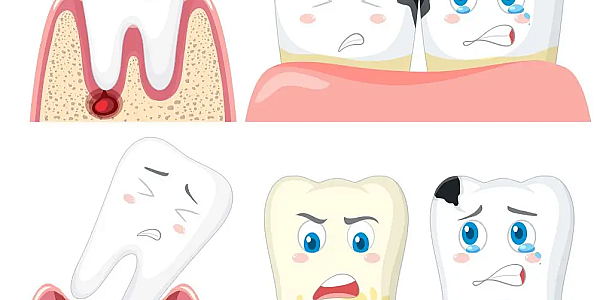A dental filling, also known as a dental restoration, is nothing more than a dental procedure used to replace damaged tissue. This procedure involves removing the affected area, cleaning the resulting space, and filling it with a special material to restore the shape, functionality, and aesthetics of the tooth. Fillings can be superficial or deep, depending on the case, and they can be temporary or permanent.
The history of dental fillings is complex and contradictory, dating back centuries, with the first forms of treatment mentioned in the writings of Ancient Egypt and Greece. Initially, fillings consisted of plants, metals like gold and silver, or materials like wax. Over time, techniques and materials evolved, culminating in the appearance of amalgam (a combination of silver, mercury, copper, and other metals) in the 19th century. Clearly, the use of amalgam raised concerns about the toxicity of mercury and aesthetic appearance. Fortunately, compared to ancient times, modern fillings have evolved significantly. Currently, the most common types of dental fillings are composite (white fillings) and ceramic. These differ in:
Aesthetic appearance: Composite and ceramic fillings are suitable for people who want a natural look and maximum functionality that closely matches natural teeth. These materials can be adapted to the natural color of the teeth and are less visible.
Adhesiveness: Composite fillings are bonded to the tooth with dental adhesives, allowing for the preservation of more healthy dental structure. In the past, amalgam required the removal of more healthy dental tissue.
Temperature tolerance: Composite and ceramic fillings have thermal conductivity closer to that of dental enamel, unlike amalgam, which can cause sensitivity to extreme temperatures.
Application process: Composite and ceramic fillings allow for less invasive techniques in tooth preparation, potentially resulting in less post-treatment discomfort and pain.
Dental fillings are necessary in a variety of situations to treat and prevent various dental problems. To determine how suitable such treatment would be, a consultation with a qualified dentist is necessary to evaluate the condition of the teeth and determine if a filling is necessary to maintain optimal dental health and functionality. Here are some cases when a dental filling is necessary:
Dental cavities: One of the most common situations where a dental filling becomes necessary is when a tooth is affected by cavities. Dental cavities are caused by bacteria that produce acid, which can erode tooth enamel and create cavities. In such cases, a filling is used to fill the resulting cavity and prevent the progression of the cavity.
Restoration of a fractured or cracked tooth: Teeth can be damaged due to trauma or excessive pressure. If a tooth has cracks or fractures, a filling can be used to restore the tooth's surface and prevent further damage.
Dental erosion: Excessive consumption of acidic foods and beverages or gastroesophageal reflux can lead to dental enamel erosion. Fillings can be used to repair eroded areas and restore tooth integrity.
Developmental defects: Sometimes, teeth may have developmental defects, such as hypoplastic teeth (with underdeveloped enamel) or malformations. Fillings can help correct these deficiencies and restore dental functionality and aesthetics.
Endodontic treatment: After a root canal treatment, the removed tissue needs to be compensated and requires reinforcement with a filling to prevent further fractures.
Preventing more severe problems: A filling can be used in the early stages of dental damage to prevent progression and avoid more invasive dental treatments or tooth extraction.
Aesthetic restoration: Fillings can be used to correct minor imperfections or discolorations in teeth, thereby restoring the natural and aesthetic appearance of the smile.
Preventing dental sensitivity: Fillings can be used to cover exposed tooth roots and prevent increased sensitivity to cold and hot temperatures or certain foods.
High-quality dental fillings, regardless of the type of material, offer multiple advantages:
Restoration of functionality: Fillings allow for the maintenance of chewing functionality in affected teeth.
Prevention of condition progression: By filling the space left after removing damaged tissue, fillings prevent the progression of cavities or other conditions.
Aesthetic restoration: Modern fillings can restore the natural appearance of teeth, contributing to a healthy and beautiful smile.
Infection prevention: By removing damaged tissue, fillings help eliminate sources of infection.
Dental fillings are essential medical procedures in dentistry for treating cavities and other dental conditions. The evolution of techniques and materials has brought modern dentistry composite and ceramic fillings, offering superior aesthetic, functional, and structural advantages for each treated case.




